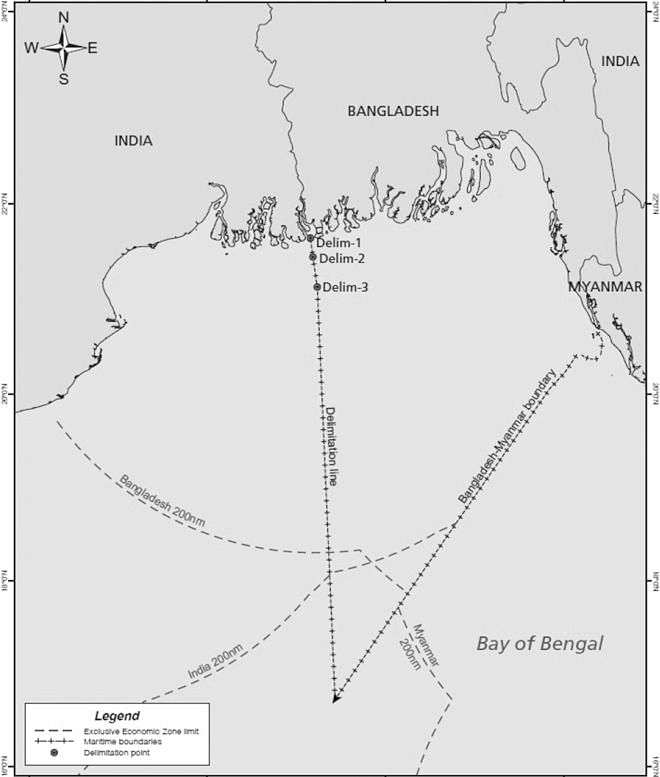Judgment by the Court of Arbitration: Victory for international law

THE Permanent Court of Arbitration (PCA) at The Hague officially conveyed the result to both parties on 7th July. The judgment is final and cannot be appealed against. Bangladesh Foreign Minister reportedly has announced on 8th July that Bangladesh has been awarded 19,467 square kilometres of the total 25,602 sq km sea area leaving 6,135 square kilometres to India. It is noted that area of dispute with India in the Bay of Bengal is much smaller than that between Bangladesh and Myanmar which was 2,83,463 square kilometers.
The judgment allows Bangladesh 200-mile exclusive economic zone, continental shelf beyond the 200-miles economic zone and to have an access for Bangladesh to the open sea, not turning it into a “sea-locked country.” Bangladesh's awarded area reportedly includes 10 off-shore blocs in the west which were in dispute with India. Although Bangladesh and India sea boundary talks started in 1974, renewed in 1978 and 1982, it could not be resolved because of the differences over methods of delimiting the boundary between the two sides.
Bangladesh submitted its statement of claim by May 2011 to the Court of Arbitration. India submitted its counter-memorial by July 2012. Rejoinder by Bangladesh was lodged on 31st January and India's reply was submitted by 31 July 2013. Oral hearings from both sides were heard by the Arbitration Court in December 2013 (9th -18th December).
The Court of Arbitration consists of three jurists as Arbitrators-- Tullio Treves of Italy, I.A. Shearer of Australia and Rudigar Wolfrum of Germany and one each nominated by Bangladesh and India. Bangladesh nominated former Judge Thomas Mensah from Ghana and India nominated Dr. P. Sreenivasa Rao, former Legal Adviser of the External Affairs Ministry.
Five arbitrators comprise the Court presided over by Rudigar Wolfrum of Germany. In July 2013 Treves resigned and a French Jurist Jean-Pierre Cot was appointed in his place in consultation with both parties. On behalf of India lawyers ,RKP Shankardass, Alain Pellet, Michael Reisman and Sir Michael Wood argued, while for Bangladesh Lawrence Martin, Philippe Sands, Payam Akhavan, Paul Reichler, Alan Boyle and James Crawford.
Since the sea boundary could not be resolved bilaterally since 1974, Bangladesh government on 8th October 2009 initiated arbitration proceedings against India before the Court of Arbitration in The Hague. UNCLOS provides a general guidelines of delimitation under Articles 15 (territorial sea) 74, (delimitation of EEZ) and 83 (delimitation of continental shelf). The interpretation and application of maritime law of delimitation have been expounded by the International Court of Justice and Tribunals.
The most significant precedent in the case of Bangladesh-India maritime dispute is arguably the judgment delivered by the International Tribunal for the Law of the Sea (ITLOS) on March 14th 2012 in the Bangladesh-Myanmar Maritime Delimitation Case.
The ITLOS judgment accepted Meghna estuary as part of relevant coast. It upheld Bangladesh cannot be a “sea-locked” state by cutting–off its boundary line from Myanmar side in the Bay of Bengal. It recognised Bangladesh's 12-mile territorial sea, 200 mile exclusive economic zone, and the rights of Bangladesh to the outer continental shelf beyond the economic zone (another 260 miles). Bangladesh has total rights over the undersea natural resources within the continental shelf as many nations have asserted mineral and land rights to their continental shelves. Most importantly Bangladesh has access to the open sea.
The most important fact is that the judgment of the Court of Arbitration together with the ITLOS judgment in 2012 has resulted in a clear-cut maritime boundary which will allow Bangladesh, India and Myanmar unhindered exploration of living resources (fishing and other living marine species) and non-living (oil, gas and minerals) resources in the Bay of Bengal. .
Bangladesh will have now not only 19,467 sq.kilo in the west but also 1,11,631 sq.kilo in the east (ITLOS judgment) in the Bay of Bengal for exploration and exploitation of its resources. One of the sources of food as well as oil and gas could be found from marine resources. As land resources deplete more attention falls on the marine resources. Another fact stands out is that Bangladesh and its neighbouring states –India and Myanmar--have peacefully settled the maritime boundary through the legal mechanism under the UNCLOS and it demonstrates all three countries have been committed to have peaceful settlement.
The judgment may assist Bangladesh concretise the Japanese proposal for a Bay of Bengal Industrial Growth Belt (BIG-B) initiative to his Bangladesh counterpart Sheikh Hasina in Tokyo in May with India and Myanmar for Japanese trade and investment. It ushers in a new era of cooperation with the neighbours in maritime area.
Finally, the Hasina government deserves commendation for its reference to the UNCLOS dispute machinery against India and Myanmar at the same time (reservations not made by both Myanmar and India to the machinery either by overlook or neglect) and the maritime wing of the foreign office in handling the case with great efficiency and dedication. On personal note, I find great satisfaction that the bilateral negotiations in which I, representing the foreign office, argued for the first time to India and Myanmar in 1974 have been resolved in Bangladesh's favour.
The writer is Former Bangladesh Ambassador to the UN, Geneva.

 For all latest news, follow The Daily Star's Google News channel.
For all latest news, follow The Daily Star's Google News channel. 




Comments